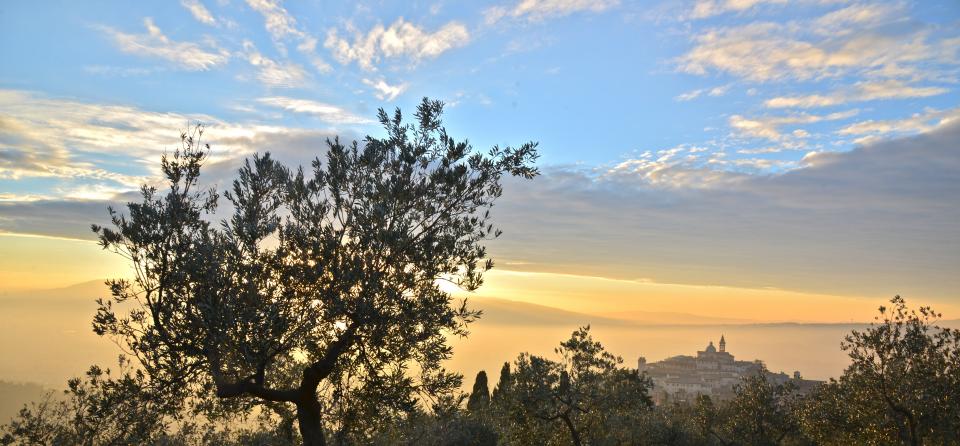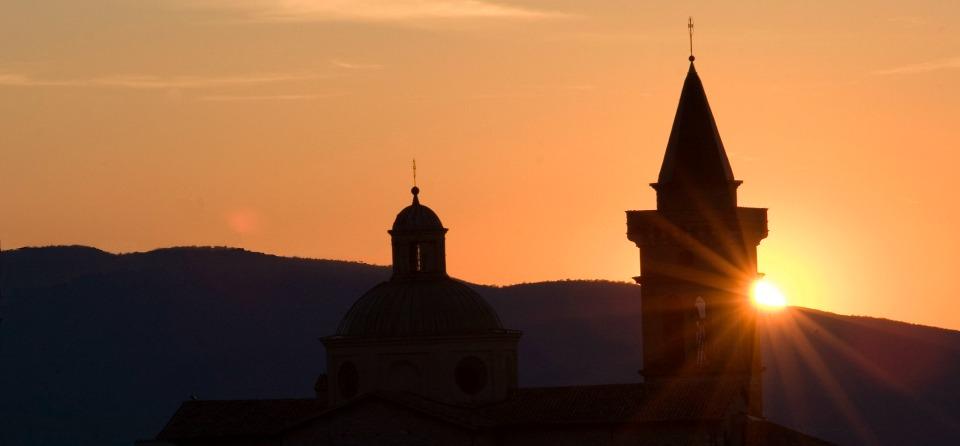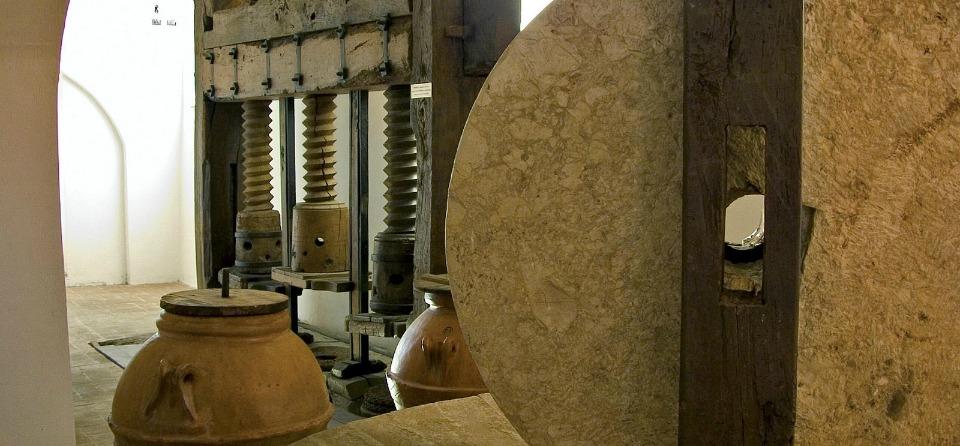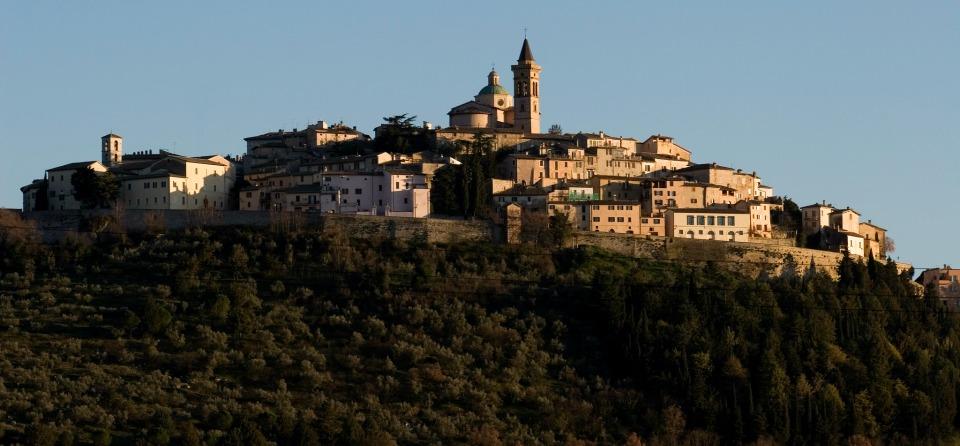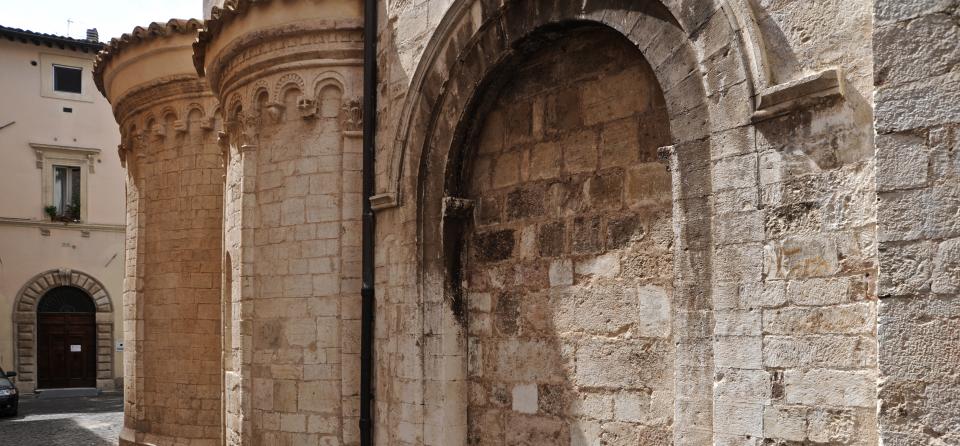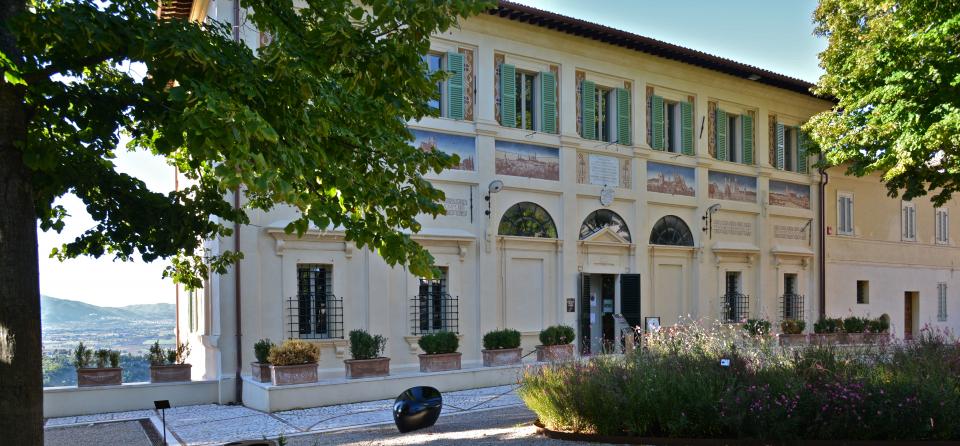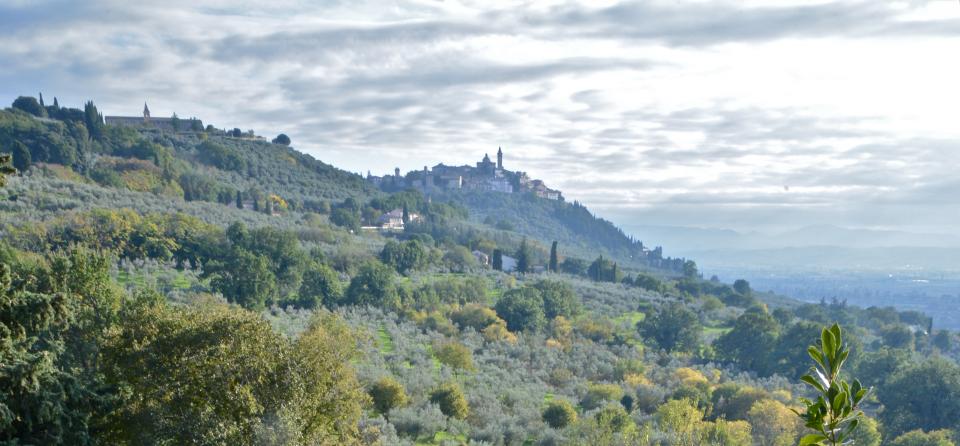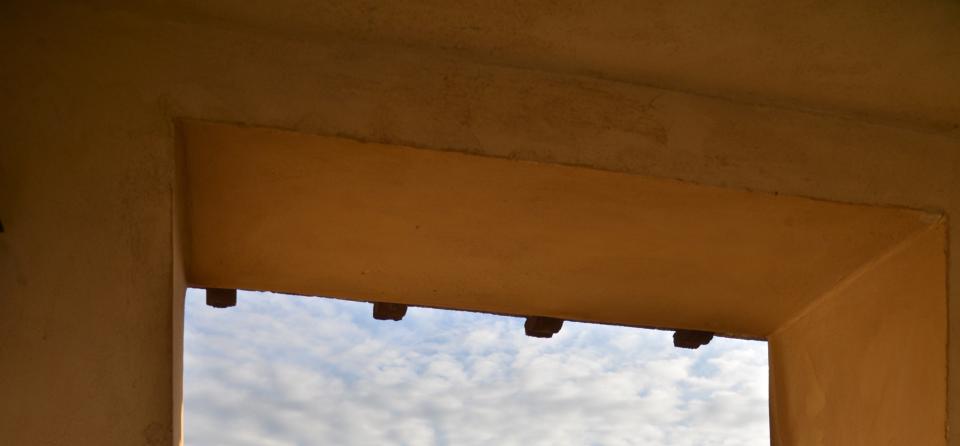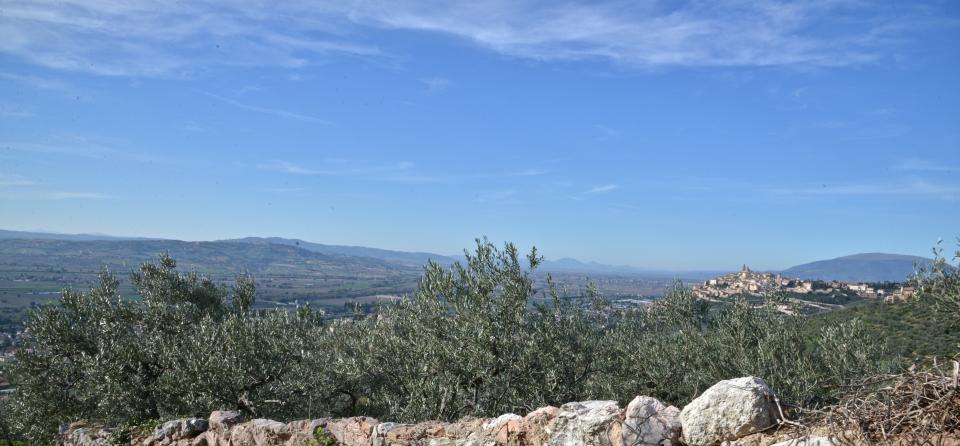- Phone: Centralino comunale +39 0742 3321
- Phone: Ufficio Turistico Comunale 39 0742 332269
- Mail: cultura@comune.trevi.pg.it
- Mail: infoturismo@comune.trevi.pg.it - Ufficio turistico
- Web: www.comune.trevi.pg.it
- Web: www.treviturismo.it
Trevi
Member of the Italian National Network
TREVI
Rising from the silvery green sea of olives.
Located in the heart of the valley of Spoleto , Trevi emerges from a silvery sea of more than three hundred thousand olive trees that surround the city. Viewed from below you see a collection of houses and buildings clinging to the hill that descends like an extreme offshoot of Mount Serano and creeps with its rocky buttresses in the silvery green of the olive planted hills. The medieval walls, grafted onto those of an earlier Roman settlement, contain the characteristic shape of a "spiral" winding along the slope of the hill.
The whole area still retains many traces of its ancient origins: the remains of the Roman walls (1st century BC.) visible in the summit area of the town, the many artifacts found in the flat area of Santa Maria Pietrarossa, which would testify to the fact that settlments were made in both locations. Not only archaeological finds but also documents attest to the importance of the settlement: Pliny, in his writings remembers the "Trebiates" (the ancient name of the people of Trevi) as one of the oldest populations in Umbria. Walking through the narrow streets and alleys of the old town you immediately realize Trevi is a little gem that has retained its medieval urban fabric, made up of churches, towers and palaces and made even more precious by the presence of important houses from the Renaissance.
Standing proud between the roofs is the dome of the Cathedral of Saint Emiliano. Built for the first time in the 12th century and dedicated to the first bishop and patron of Trevi. Saint Emiliano's martyrdom is linked to the legend that surrounds the oldest olive tree in Italy. Named after the first bishop of Trevi and located a few miles away from Trevi. The Duomo, enlarged in the 15th century and rebuilt in the 19th century houses a beautiful baptismal font from the 15th century, the relics of Saint Emiliano and a beautiful altar dedicated to the Blessed Sacrament.
Villa Fabri and the Theatre Clitunno
Upon arriving in Trevi there is the entrance to the seventeenth-century Villa Fabri. The beautiful Villa Fabri was built on 500C foundations, and was inaugurated in 1603 by Jerome Fabri "for the solace of his old age, and for the posterity of the nation", as reported in his “Historia Universal Durastante Natalucci “ of 1745 .
After many vicissitudes, in 1891 Bishop Giuseppe Giovanni Hais bought it for the Bohemian College of Rome, and expanded it with the construction of the right wing.
From the 1940s until 1988 during the summer it hosted the Pontifical Ethiopian College .
It was then sold to private individuals, and in 2000 passed into the hands of the towns administrators. It finally opened to the public after restoration on October 31, 2008. The Villa now hosts the tourist office.
The Villa features in the ceilings of the rooms on the main floor well preserved large frescos from the first half of the 17th century.
During the period in which the villa was owned by the Bohemian College the facade was decorated with monochrome designs depicting Prague and five other towns in Bohemia. The decoration of the chapel is richly painted (in the apse is depicted the saints of Bohemia with Wenceslas Square in the centre) .
The external decoration of the building and the place of worship was built between 1912 and 1914 , by artists B. Cila and Pantaleone Mayor the latter was a follower of the school of Beuron art movement that flourished in Sweden in the second half of the 19th century.
The decoration of the Chapel of the Bohemians, after the Crypt of Monte Cassino is the second most important work of the Beuron school in Italy. It was to pave the way for art nouveau and modernism.
A few steps from Villa Fabri stands the Clitunno Theatre, built in 1875, it was designed by the architect Domenico Mollaioli with the contributions of individuals and the municipality. It was inaugurated in 1877 with a performance of the opera "Maria Roan " by Gaetano Donizetti . It consists of two tiers and a gallery. The curtain, is signed and dated 1877 by Domenico Bruschi, one of the main protagonists of the art of painting in Perugia after the unification of Italy. It represents the emperor Caligula offering sacrifices to the god Clitunno .
For a century it was the centre of cultural, recreational and social aspects of Trevi. In the thirties and fifties famous masked balls where held here .
In 1932 various restoration works were undertaken. In 1955, the theatre was transformed into a cinema. Later, purchased outright by the town of Trevi the theatre was completely restored between 1987 and 1993. Today it hosts performances of the highest standard side by side with local cultural activities .
The Museum Complex of St. Francis
The Museum of San Francesco in Trevi, opened in October 1996, is found in a part of the former convent of the Frati minori Conventuali. The building was built in the 13thcentury and completely rebuilt in the first half of 17th century. The Cloister is beautifully decorated with frescoes depicting the story of the life of Saint Francis, the work of Bernardino Gagliardi (1609-1660), a painter born in Citta di Castello. The Museum of the Olive Tree (Museo della Civiltà dell’Ulivo) was inaugurated in 2007 it is dedicated to the main product of Trevi - extra virgin olive oil.
The Art Gallery, comprising of three rooms, houses works of extraordinary artistic and historical interest dating from the medieval and Renaissance periods. There are a triptych and quadrittico with the stories of Christ's life by Giovanni di Corraduccio from the 15th century; the Coronation of the Virgin by Giovanni di Pietro, known as “The Spaniard”; a Madonna with Child by Pinturicchio in the early period and the great altarpiece of the Assumption of the Virgin by Alessandro Turchi, known as Orbetto, dating from 1640 .
The Museum of the City and the Territory displays artifacts dating from Roman times to the 19th century, while the archaeological museum has excavated material (stones, inscriptions, pottery) , mainly from the Pietrarossa settlement, site of the ancient Roman Trebiae .
Part of the museum complex is the Church of San Francesco, built in the first half of the 14th century on a pre-existing religious building of the 13th century is presented in the style of the mendicant orders - in one room with a trussed roof. The interior retains traces of frescoes from the 14th, 15th and 16th centuries. On the wall dating back to 1509 there is a 16th century organ, one of the oldest in the world, together with a recently restored iconostasis crucifix painted in the first half of the 14thcentury. The church and monastery testify to the presence Saint Emiliano who preached to the people of Trevi in the town square in the year 1213 where he recounted the famous donkey episode narrated by the Pisans in "De conformitate ."
The Church of the ”Madonna delle Lacrime”
The origin of the church is due to a miraculous event tied to a painted image of the Virgin which still exists in the current position on the altar of the left transept of the sanctuary, representing the Madonna with child and originally included to the right of the image of St. Francis of Assisi, now lost. The devotional icon was made by Antonio Diotallevi, citizen of Trevi, in a wall of his home on 3rd October, 1483, the eve of the feast of St. Francis. The house stood near the place called the Costarella San Costanzo. On the evening of Friday 5th August 1485 the Virgin's eyes cried blood-red tears.
The church of the “Madonna delle Lacrime” in Trevi is a fine example of an Renaissance church. The realisation of this sacred building began on May 26th, 1487 by Antonio di Giorgio of Settignano Marchisi and was then completed by Francesco da Pietrasanta in 1522.
Starting your visit you can admire several frescoed chapels but certainly the most notable are “la Capella dell'Adorazione dei Magi” by Perugino (1521) and the “la Capella del trasporto di Cristo al Sepolcro” by Giovanni di Pietro(1520).
The Capella dell'Adorazione dei Magi” also known as the Nativity, or the Epiphany, is the best known chapel in the church, having been painted and signed by Pietro Vannucci "Il Perugino " in 1522 and is one of the last works of the Master.
The entire back wall is occupied by the beautiful nativity scene with figures in adoration. On the sides are depicted the apostles Peter and Paul. The composition of the main scene reworks the Adoration of the Magi in the Oratorio dei Bianchi in Città della Pieve, executed in 1504. Inscribed on the keystone of the arch is the coat of arms of the noble family of Trevi, Valenti .
The Chapel of St. Francis is found in the left arm of the cross aisle and was executed between 1518 and 1520 by Giovanni di Pietro. The frescoes, Trasporto di Cristo al Sepolcro, by Giovanni di Pietro, clearly draw inspiration from the panel painted in 1507 by Raphael for the Baglioni Chapel in San Francesco al Prato in Perugia. The central scene is the Entombment of Christ at the tomb of various saints. In the upper rear window are depicted an order of Benedictine monks (Olivetans, who dressed in white) in prayer.
On the sides are depicted St. Joseph and St. Ubaldo. In 1518, the rectors of the church, commissioned Giovanni di Pietro the frescoes in the chapel of St. Francis to Spain. The artist painted the prophets Jeremiah, Isaiah and St. Augustine , with portraits of the Lateran Canons and the angels, Christ carried to the tomb, Saints Ubaldo and Joseph. The museum of Trevi contains two canvases with St. Cecilia and St. Catherine of Alexandria, which, from the church of the Madonna delle Lacrime, were painted by Giovanni di Pietro in the last decade of his career. Other works by the same artist in Trevi can be found at:-http://www.protrevi.com/protrevi/Smartin2.asp andhttp://www.protrevi.com/protrevi/raccoltarte.asp.
FOOD AND WINE
The extra virgin olive oil and black celery of Trevi.
Trevi is intrinsically linked to its landscape, terracing of hillsides supported by dry stone walls , which are an example of hydraulic- agrarian simplicity and effectiveness. The legacy of a bygone era.
On this soil, otherwise arid and unproductive , is produced an exceptional extra virgin olive oil which is well represented in the traditional local cuisine.
Trevi is considered the "Olive Oil Capital" . A demonstration of the link between the land and this type of culture , in the hamlet of Bovara, just below Trevi, is the olive of St. Emiliano. According to popular tradition it is an olive tree more than 17 centuries old, tied to which, in the year 304 DC the bishop was martyred the patron saint of Trevi, St Emiliano. ( is celebrated January 28 ) . The olive tree, privately owned, has a base circumference of more than nine meters and a height of five meters. Recent analyses carried out by the Experimental Institute for Olive Growing in Spoleto , have established that this olive tree does not belong to any of the cultivars throughout the area. This could explain its resistance to frost that periodically inflict severe damage to olive trees in this area.
In additional to olive oil , another product that clearly characterizes Trevi and its territory, is the local black celery which is produced on the small strip of land on the plain below Trevi, called Canapine. The Trevi black celery is a local ecotype and its producers are recognized by the Slow Food Movement as sustaining a rare cultivar. It is cultivated using traditional farming practices that are handed down from generation to generation, including irrigation, which uses only the clear water from the local river and spring, Clitunno. According to tradition, the black celery is sown on Good Friday and is cultivated until the stem reaches thirty inches tall. The stems are then covered either by building up the soil around them or simply covered so that they remain white. The black celery is harvested from October to December. The celery is enjoyed with the local extra virgin olive oil and in a favourite local dish is stuffed with Trevi sausages and cooked like a lasagne.
EVENTS IN TREVI
Scents, tastes and traditions of the “Olive Oil Capital”
Trevi hosts many national events to promote the region and its customs and traditions. In particular in October there is the “Ottobre Trevana”(http://www.terzieri.com ) during which is celebrated the “Sagra del Sedano Nero” (black celery festival) organised by Pro Trevi. The event that celebrates the new extra virgin olive oil is “Festivol” (www.festivol.it )which traditionally takes place on the 1st and 2nd of November, while in the spring of each year there is “Pic & Nic” (www.picnicatrevi.it ) in the olive groves surrounding Trevi which includes tastings of various local specialties.
